1997 GMC SIERRA automatic transmission
[x] Cancel search: automatic transmissionPage 236 of 436
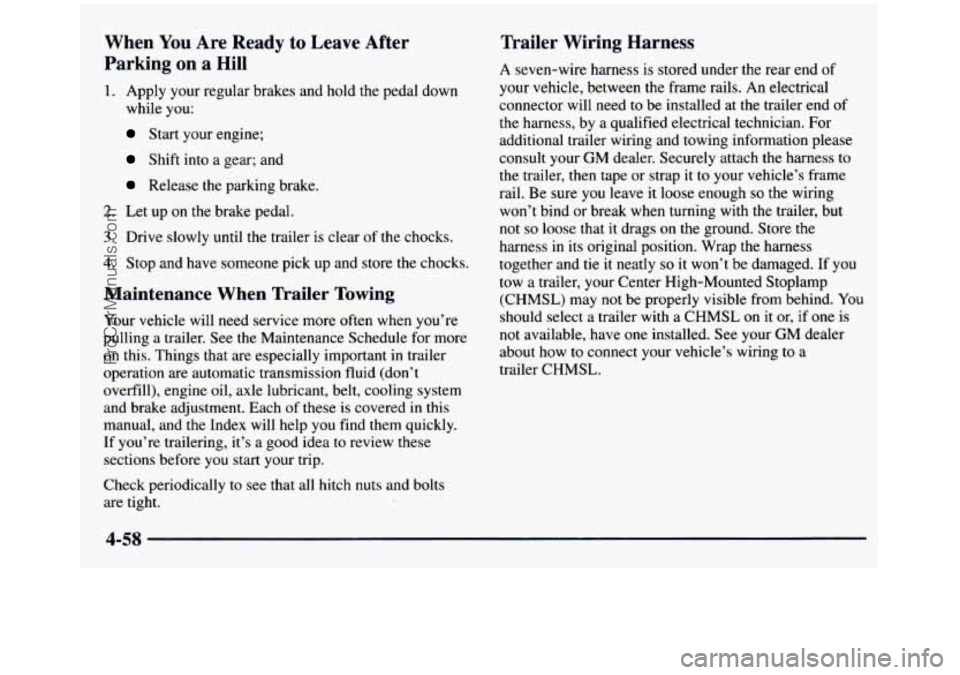
When You Are Ready to Leave After
Parkine
on a Hill
1. Apply your regular brakes and hold the pedal down
while you:
Start your engine;
Shift into a gear; and
Release the parking brake.
2. Let up on the brake pedal.
3. Drive slowly until the trailer is clear of the chocks.
4. Stop and have someone pick up and store the chocks.
Maintenance When Trailer Towing
Your vehicle will need service more often when you’re
pulling a trailer. See the Maintenance Schedule for more
on this. Things that are especially important
in trailer
operation are automatic transmission fluid (don’t
overfill), engine oil, axle lubricant, belt, cooling system
and brake adjustment. Each
of these is covered in this
manual, and
the Index will help you find them quickly.
If you’re trailering, it’s a good idea to review these
sections before you start your trip.
Trailer Wiring Harness
A seven-wire harness is stored under the rear end of
your vehicle, between
the frame rails. An electrical
connector will need to be installed at the trailer end of
the harness, by a qualified electrical technician. For
additional trailer wiring and towing information please
consult your
GM dealer. Securely attach the harness to
the trailer, then tape or strap
it to your vehicle’s frame
rail. Be sure you leave it loose enough
so the wiring
won’t bind or break when turning with the trailer, but
not
so loose that it drags on the ground. Store the
harness in its original position. Wrap the harness
together and tie
it neatly so it won’t be damaged. If you
tow
a trailer, your Center High-Mounted Stoplamp
(CHMSL) may not be properly visible from behind.
You
should select a trailer with a CHMSL on it or, if one is
not available, have one installed. See your
GM dealer
about how to connect your vehicle’s wiring
to a
trailer CHMSL.
Check periodically to see that all hitch nuts and bolts
are tight.
4-58
ProCarManuals.com
Page 239 of 436
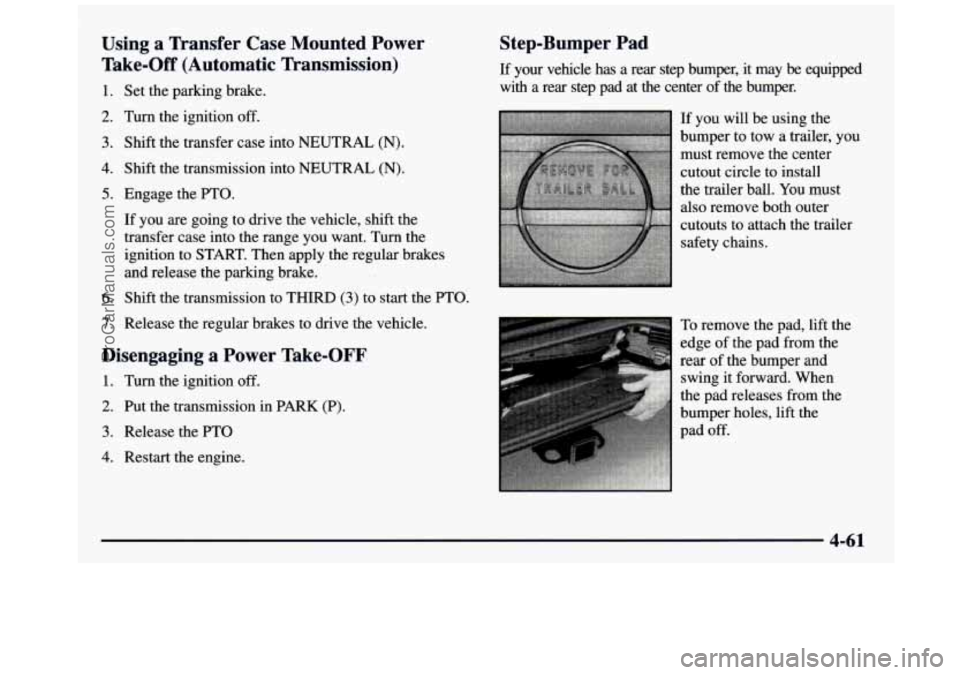
Using a Transfer Case Mounted Power
Take-Off (Automatic Transmission)
1. Set the parking brake.
2. Turn the ignition off.
3. Shift the transfer case into NEUTRAL (N).
4. Shift the transmission into NEUTRAL (N).
5. Engage the PTO.
If you are going to drive the vehicle, shift the
transfer case into the range you want. Turn the
ignition to START. Then apply the regular brakes
and release the parking brake.
6. Shift the transmission to THIRD (3) to start the PTO.
7. Release the regular brakes to drive the vehicle.
Disengaging a Power Take-OFF
1. Turn the ignition off.
2. Put the transmission in PARK (P).
3. Release the PTO
4. Restart the engine.
Step-Bumper Pad
If your vehicle has a rear step bumper, it may be equipped
with a rear step pad at the center of the bumper.
If you will be using the
bumper to tow a trailer, you
must remove the center
cutout circle to install
the trailer ball. You must
also remove both outer
cutouts to attach the trailer
safety chains.
To remove the pad, lift the
edge
of the pad from the
rear of the bumper and
the pad releases from the
bumper holes, lift the
pad
off.
swing it forward. When
4-61
ProCarManuals.com
Page 243 of 436
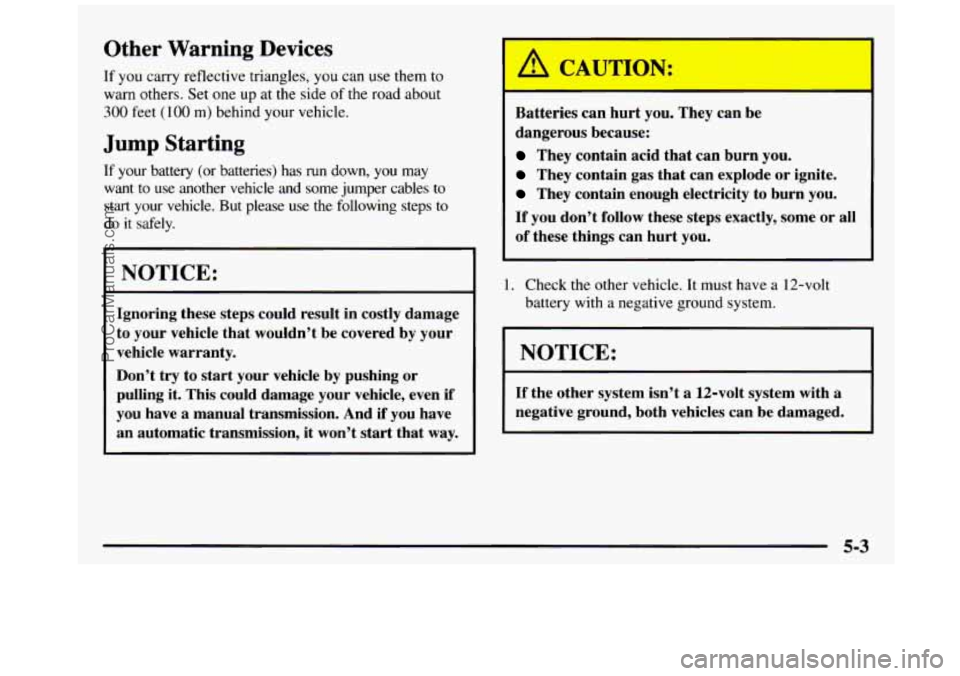
Other Warning Devices
If you carry reflective triangles, you can use them to
warn others.
Set one up at the side of the road about
300 feet (100 m) behind your vehicle.
Jump Starting
If your battery (or batteries) has run down, you may
want to use another vehicle and some jumper cables
to
start your vehicle. But please use the following steps to
do it safely.
1 NOTICE:
~ Ignoring these steps could result in costly damage
to your vehicle that wouldn’t be covered by your
vehicle warranty.
Don’t try to start your vehicle by pushing or
pulling it. This could damage your vehicle, even
if
you have a manual transmission. And if you have
an automatic transmission, it won’t start that way. Batteries can hurt
you. They can be
dangerous because:
They contain acid that can burn you.
They contain gas that can explode or ignite.
They contain enough electricity to burn you.
If you don’t follow these steps exactly, some or all
of these things can hurt you.
1. Check the other vehicle. It must have a 12-volt
battery with
a negative ground system.
I NOTICE:
I I
If the other system isn’t a 12-volt system with a
negative ground, both vehicles can be damaged. I
-- 5-3
ProCarManuals.com
Page 244 of 436
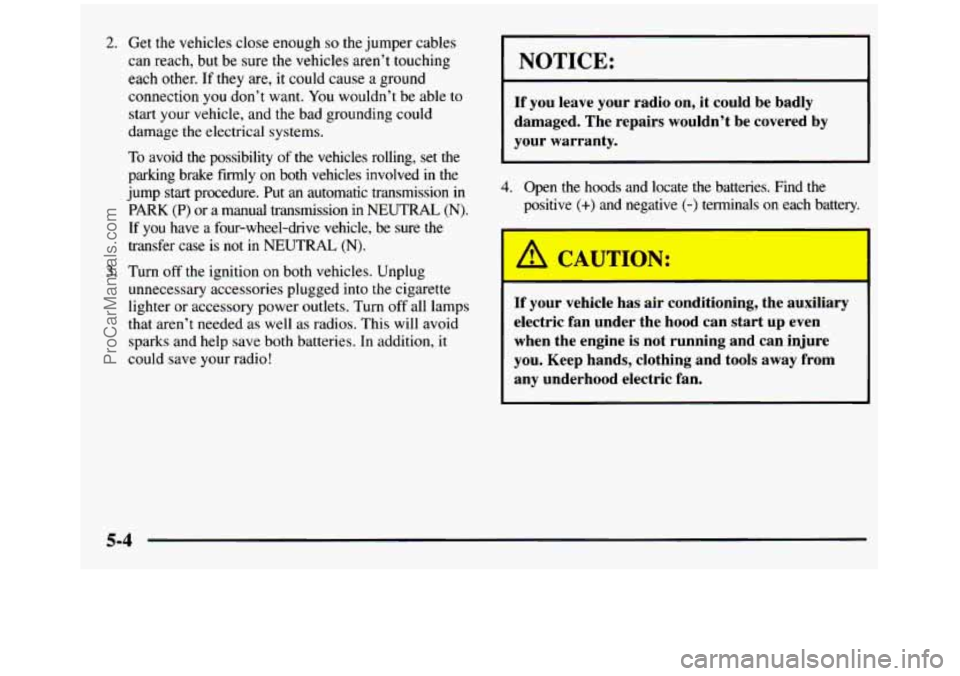
2. Get the vehicles close enough so the jumper cables
can reach, but be
sure the vehicles aren’t touching
each other. If they are, it could cause a ground connection you don’t want. You wouldn’t be able to
start your vehicle, and the bad grounding could
damage the electrical systems.
To avoid the possibility of the vehicles rolling, set the
parking brake
fmly on both vehicles involved in the
jump stat procedure. Put an automatic transmission in
PARK (P) or a manual transmission in NEUTRAL (N).
If you have a four-wheel-drive vehicle, be sure the
transfer case is not
in NEUTRAL (N).
3. Turn off the ignition on both vehicles. Unplug
unnecessary accessories plugged into the cigarette
lighter or accessory power outlets. Turn
off all lamps
that aren’t needed as well
as radios. This will avoid
sparks and help save both batteries.
In addition, it
could save your radio!
I NOTICE:
If you leave your radio on, it could be badly
damaged. The repairs wouldn’t be covered by
your warranty.
4. Open the hoods and locate the batteries. Find the
positive
(+) and negative (-) terminals on each battery.
If your vehicle has air conditioning, the auxiliary
electric fan under the hood can start
up even
when the engine is not running and can injure
you. Keep hands, clothing and tools away
from
any underhood electric fan.
5-4
ProCarManuals.com
Page 250 of 436
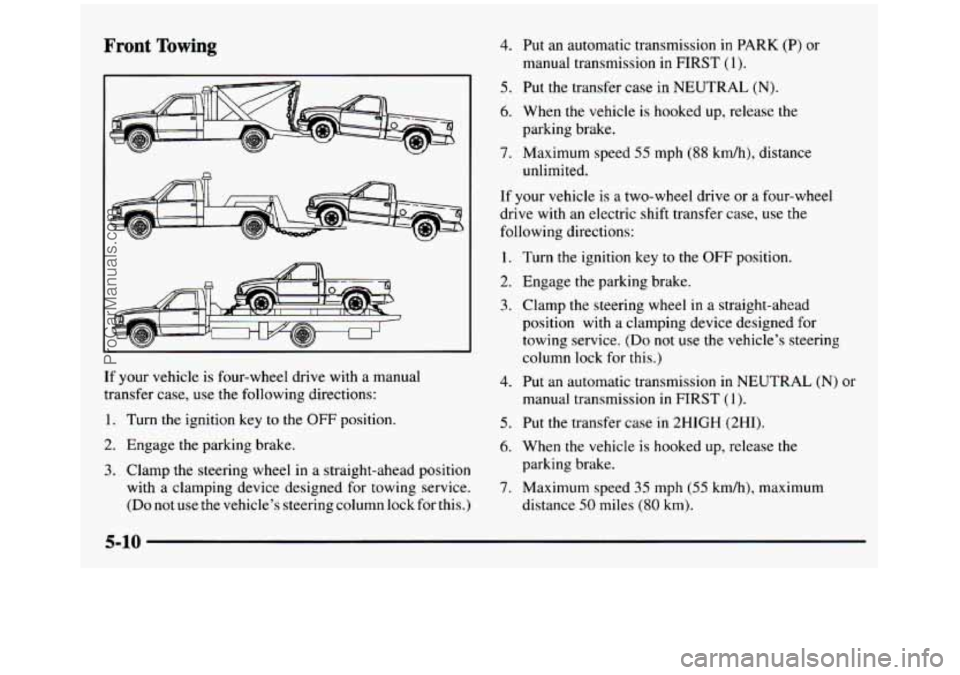
Front Towing 4. Put an automatic transmission in PARK (P) or
manual transmission in FIRST
(1).
5. Put the transfer case in NEUTRAL (N).
6. When the vehicle is hooked up, release the
7. Maximum speed 55 mph (88 kmh), distance
If your vehicle is a two-wheel drive or a four-wheel
drive with an electric shift transfer case,
use the
following directions: parking brake.
unlimited.
1.
2.
3.
If your vehicle is four-wheel drive with a manual transfer case, use the following directions:
1. Turn the ignition key to the OFF position.
2. Engage the parking brake.
3. Clamp the steering wheel in a straight-ahead position
with a clamping device designed for towing service.
(Do not use the vehicle’s steering column lock for this.)
4.
5.
6.
7.
Turn the ignition key to the OFF position.
Engage the parking brake.
Clamp the steering wheel in a straight-ahead
position with
a clamping device designed for
towing service.
(Do not use the vehicle’s steering
column lock
for this.)
Put an automatic transmission
in NEUTRAL (N) or
manual transmission in FIRST (1).
Put the transfer case
in 2HIGH (2HI).
When
the vehicle is hooked up, release the
parking brake.
Maximum speed
35 mph (55 km/h), maximum
distance
50 miles (80 km).
5-10
ProCarManuals.com
Page 253 of 436

If you get the overheat warning with no sign of steam,
try this for a minute or
so:
1. If you have an air conditioner, turn it off.
2. Turn on your heater to full hot at the highest fan
speed and open the window
as necessary.
3. If you’re in a traffic jam, shift to NEUTRAL (N);
otherwise, shift to the highest gear while
driving
-- AUTOMATIC OVERDRIVE (@)
for automatic transmissions.
If you no longer have
the overheat warning, you can
drive. Just
to be safe, drive slower for about 10 minutes.
If the warning doesn’t come back
on, you can
drive normally.
If the warning continues, pull over, stop, and park your
vehicle right away.
If there’s still no sign of steam, push the accelerator until
the engine speed is about twice as fast as normal idle
speed. Bring the engine speed back to normal idle speed
after two or three minutes. Now see if the warning stops.
But then, if
you still have the warning, turn oflthe
engine and get everyone out
of the vehicle until it
cools down.
Cooling System -- Gasoline Engines
When you decide it’s safe to lift the hood, here’s what
you’ll see:
A. Coolant Recovery Tank
B. Radiator Pressure Cap
C. Engine Fan(s)
You may decide
not to lift the hood but to get service
help right away.
ProCarManuals.com
Page 262 of 436
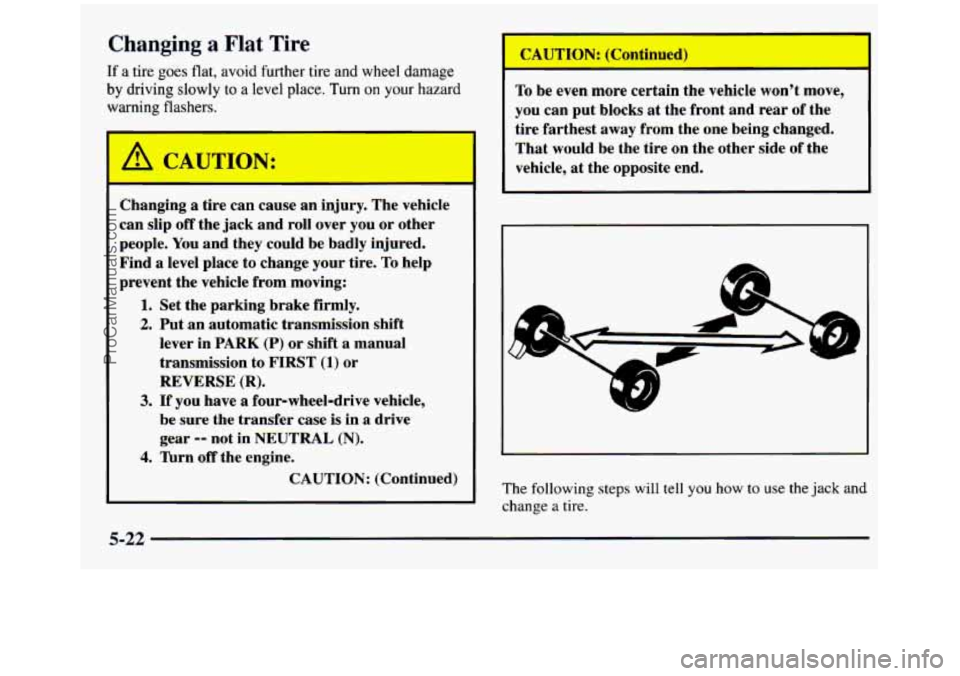
Changing a Flat Tire
If a tire goes flat, avoid further tire and wheel damage
by driving slowly to a level place. Turn on your hazard
warning flashers.
I A CAUTION:
Changing a tire can cause an injury. The vehicle
can slip
off the jack and roll over you or other
people. You and they could be badly injured.
Find a level place
to change your tire. To help
prevent the vehicle from moving:
1. Set the parking brake firmly.
2. Put an automatic transmission shift
lever in
PARK (P) or shift a manual
transmission to
FIRST (1) or
REVERSE (R).
3. If you have a four-wheel-drive vehicle,
be
sure the transfer case is in a drive
gear
-- not in NEUTRAL (N).
4. Turn off the engine.
CAUTION: (Continued)
To be even more certain the vehicle won’t move,
you can put blocks at the front and rear of the
tire farthest away from the one being changed.
That would be the tire on the other side
of the
vehicle, at the opposite end.
The following steps will tell
you how to use the jack and
change
a tire.
5-22
ProCarManuals.com
Page 277 of 436
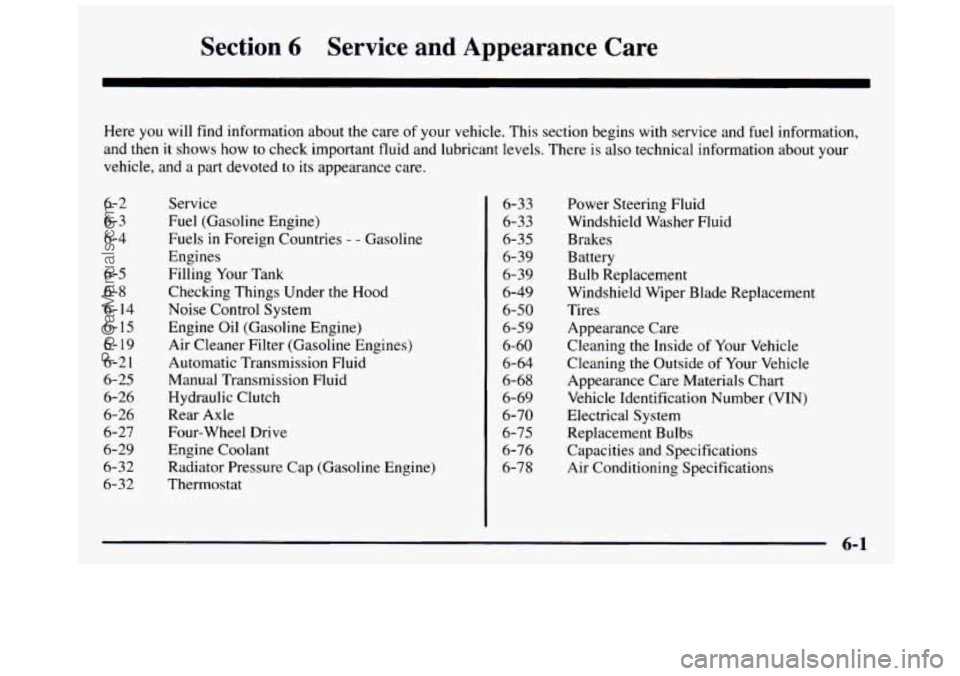
Section 6 Service and Appearance Care
Here you will find information about the care of your vehicle. This section begins with service and fuel information,
and then it shows how
to check important fluid and lubricant levels. There is also technical information about your
vehicle, and a part devoted to its appearance care.
6-2
6-
3
6-4
6-5
6-8
6- 14
6- 15
6- 19
6-2 1
6-25
6-26
6-26 6-27
6-29
6-32
6-32 Service
Fuel (Gasoline Engine)
Fuels
in Foreign Countries - - Gasoline
Engines
Filling Your Tank
Checking Things Under the Hood
Noise Control System
Engine Oil (Gasoline Engine)
Air Cleaner Filter (Gasoline Engines)
Automatic Transmission Fluid
Manual Transmission Fluid
Hydraulic Clutch
Rear Axle
Four-wheel Drive
Engine Coolant Radiator Pressure Cap (Gasoline Engine)
Thermostat 6-33
6-33 6-35
6-39
6-39
6-49 6-50
6-59
6-60
6-64
6-68
6-69
6-70 6-75
6-76
6-78 Power Steering Fluid
Windshield Washer Fluid
Brakes
Battery
Bulb Replacement
Windshield Wiper Blade
R
Tires
Appearance Care .eplacement
Cleaning the Inside
of Your Vehicle
Cleaning
the Outside of Your Vehicle
Appearance Care Materials
Chart
Vehicle Identification Number (VIN)
Electrical System Replacement Bulbs
Capacities and Specifications
Air Conditioning Specifications
ProCarManuals.com